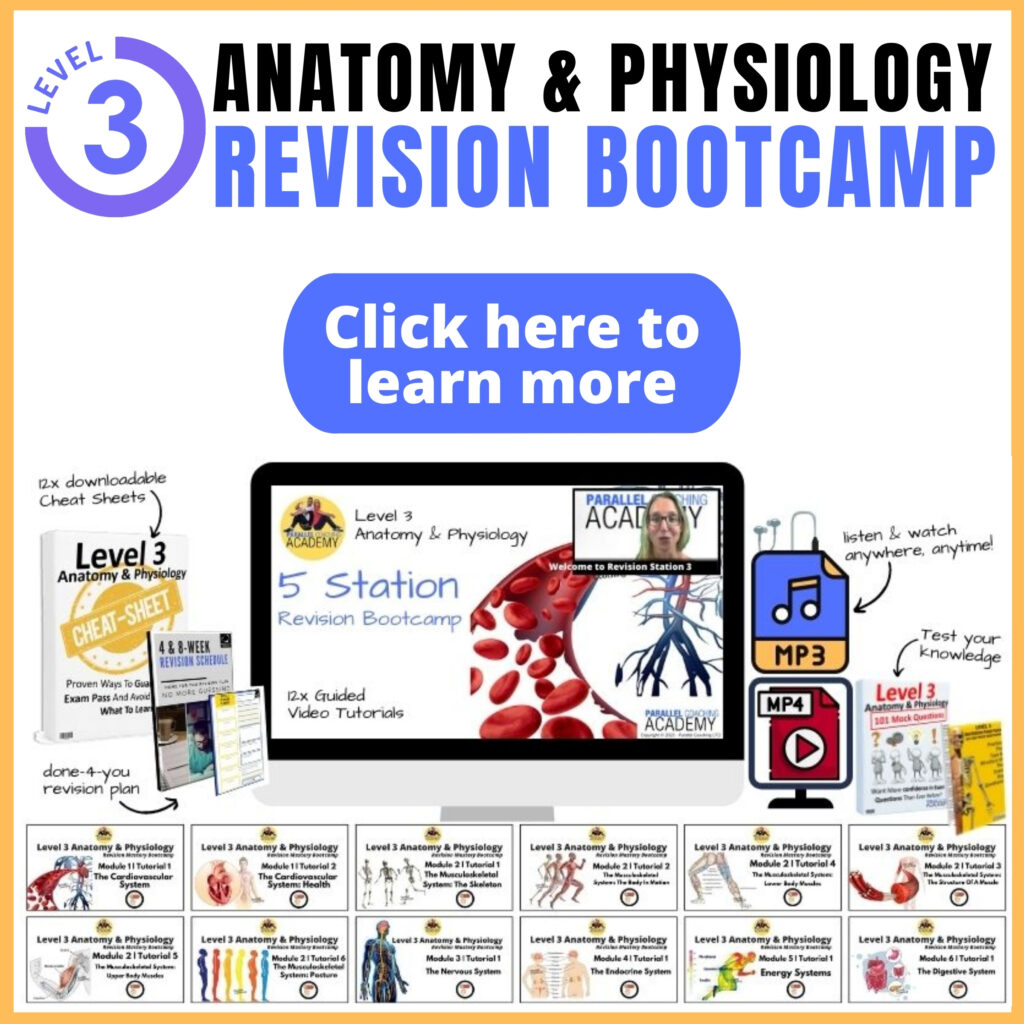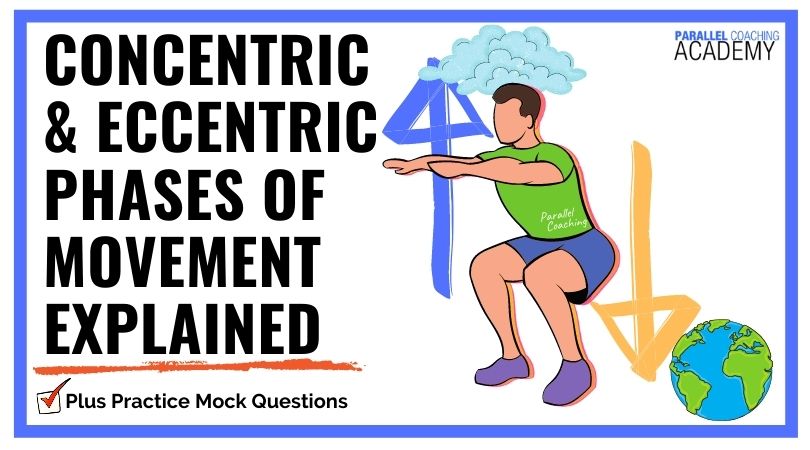In this blog, we’ll explore both Concentric and Eccentric Phases of Movement including an easy way to remember the difference between the two phases and how this will help your planning as a FITPRO.
Watch the 7-minute training video, and then test your knowledge with three more fitness exam questions at the bottom of the blog
Firstly, Let’s explore what we mean by “phases of movement”
What is a phase of movement
Every exercise has two phases of movement, a lifting phase, and a lowering phase. These are called the concentric and eccentric phases of the movement.
It is important to understand these phases of movement and be able to analyze exercises competently.
Once you understand that each exercise has a concentric and an eccentric phase, you can observe joint actions and work out which muscles are the prime movers in the exercise.
This will not only help you in your Level 2 and 3 anatomy exam but also help you as a FITPRO, in your planning and instruction of client sessions.
What is the Concentric Phase of movement?
The concentric phase is the lifting phase
It is the phase of movement whereby the load (you or the weight) is resisting gravity.
In the concentric phase, the load is always moving towards the clouds
An easy way to remember this is C = Concentric, and C= Clouds
For example in a bodyweight squat, the concentric phase is the lifting phase, as we stand up from the lowest point.
In a press-up, the concentric phase is the lifting phase as we lift our body weight against gravity and straighten the arms.
Which muscle is working in the concentric phase?
During the concentric phase, the Agonist muscles (also known as Prime Mover) and the synergist muscles shorten and contract. This creates joint actions that create a movement against the force of gravity.
So if you ever want to find out which muscles are working during any exercise:
- Work out which phase of movement is concentric
- Then look at which joint actions occur
- Now notice which muscles are getting shorter during this concentric phase
What is the Eccentric Phase of movement?
The eccentric phase of the movement is the lowering phase, whereby the prime mover (agonist) muscles are lengthening as the load is lowered down toward the floor.
In the eccentric phase, the load is always moving towards the Earth
An easy way to remember this is E = Eccentric, and E = Earth
For example in a bodyweight squat, the eccentric phase is the lowering phase, as we lower down towards the floor.
In this exercise, the eccentric phase features knee flexion and hip flexion. The agonist muscles of the Quads and the Glutes lengthen. This means that at the lowest point of the movement the prime movers are maximally lengthened, and ready to maximally shorten and contract throughout the concentric phase.
You can find out more about Concentric and Eccentric Muscle Contractions in this blog:
CLICK HERE
How to work out the Concentric Phase of any movement
Although some movements and exercises are quite easy to work out the Concentric and Eccentric Phase of Mvoment; other exercises are a little more tricky.
For example, it may be easy to see that a Biceps Curl, has the Concentric phase when you lift the dumbbell up, and eccentric phase when you lower the dumbbell towards the earth.
However, what about the Lat Pull Down? or Cable Triceps Pushdown?
The key thing to remember is that it is the load that is going towards the CLOUDS on the concentric phase (not your body), and the load that is going to wads the EARTH in the eccentric phase.
Let’s look at the Lat Pull Down.
The weight stack rests whilst the handle/ bar is suspended in the air.
Then when you pull down on the bar, the pulley system lifts the weight stack. This is the concentric phase because the load (the weight stack) is resisting the force of gravity.
The Eccentric phase is when you lower the weight stack back to its resting position. To do this you lengthen the latissimus dorsi and straighten your arms raising the bar back to its suspended starting position.
So it looks like it is opposite
But remember it is the weight stack that makes indicates the concentric and eccentric phase (not your body position)
Now apply this same system to the following mock questions to test your knowledge
Test your knowledge with today’s fitness exam mock questions:
[NOTE: The answers are below the 3rd questions]
Q1: What joint action occurs during the concentric phase of a Biceps Curl?
A. Elbow Flexion
B. Elbow Extension
C. Shoulder Rotation
D. Lateral Flexion
Q2: During a Cable Triceps Extension, what joint action occurs in the Eccentric phase?
A. Elbow Flexion
B. Elbow Extension
C. Shoulder Rotation
D. Lateral Flexion
Q3: During a Dumbbell Lateral Raise, which muscle is shortening in the Concentric Phase?
A. Latissimus Dorsi
B. Triceps Brachii
C. Deltoids
D. Biceps Brachii
Answers to the mock questions are :
Question 1= A, Question 2 = A, Question 3 = C
If you want more mock questions like this, then you can download more Free Mock Questions: DOWNLOAD NOW
Need More Help with your Level 3 Anatomy Revision?
For Trainee FITPROS Taking Their L3 Anatomy & Physiology Exam.
Learn, Revise & Pass Your Level 3 Anatomy & Physiology Exam In Under 10-hours
(Without Having To Spend Hours Revising Or Feeling Overwhelmed)
If you want to get your revision structured, learn everything you need to know and feel confident on exam day, then click the link below:

Dedicated to More
Hayley “Concentric and Eccentric Phases of Movement” Bergman
Parallel Coaching
P.S. You can also find us on the following platforms:
Instagram: Follow Now
Facebook: Like Our Page
Twitter: Tweet Us
YouTube: Subscribe Here
More Anatomy Revision Blogs: HERE

